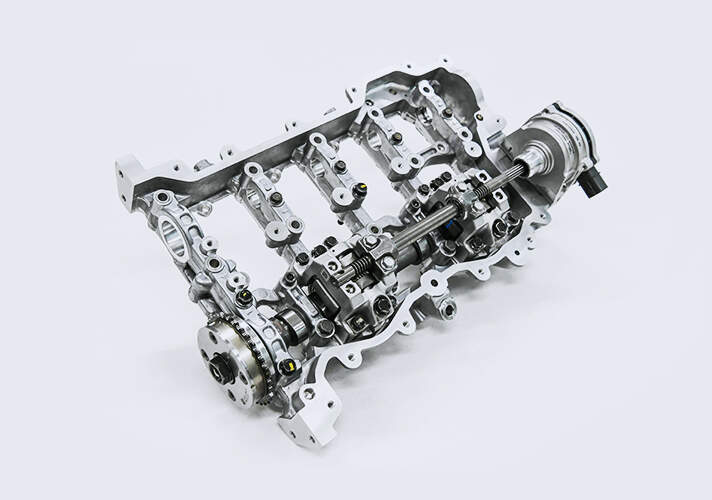
In addition to promoting proper lubrication. The cylinder head contains the spark plugs on spark-ignition gasoline engines and usually the fuel nozzle on compression-ignition diesel engines.

The process of conditioning the surface finish of the cylinder walls.
What do cylinders do in an engine. The cylinder is the power-producing element of the steam engine powering a steam locomotive. The cylinder is made pressure-tight with end covers and a piston. A valve distributes the steam to the ends of the cylinder.
Cylinders were cast in iron and later made of steel. The cylinder casting includes other features such as in the case of the early. The cylinders in which the pistons operate are cast into the block as are mountings for ancillary equipment such as a filter for the oil which lubricates the engine and a pump for the fuel.
An oil reservoir called the sump is bolted underneath the crankcase. A cylinder is the power unit of an engine. Its the chamber where the gasoline is burned and turned into power.
For more on what goes on inside the cylinders see How Engines Work Most cars and SUV enginess have four six or eight cylinders. Through every stroke made in a 4 cylinder engine one cylinder is always in the power stroke and the rest are all at different positions than each other. This gives the crankshaft a much more streamlined motion which translates to smooth engine operation on the whole.
The 4 cylinder engine generates power every 90-degree rotation of the crankshaft. At its most basic the piston is simply a solid cylinder of metal which moves up and down in the hollow cylinder of the engine block. The piston itself is slightly smaller than the hole it moves in but it has piston rings under tension to achieve an nearly air-tight seal once it is installed within the engine cylinder.
Whether you have a motorcycle outboard engine some sort of powersport vehicle or an ATV boring an engines cylinders is an important step in the engine rebuilding process and is an economical way of repairing damaged and worn out cylinders in engine blocks. The process if done properly literally restores your engine block back to factory. The cylinder head contains the spark plugs on spark-ignition gasoline engines and usually the fuel nozzle on compression-ignition diesel engines.
On most engines the valves that control the admission of fresh airfuel mixtures and the escape of burned fuel are also located in the head. The number of cylinders determines the size and placement of the block with most cars having between four and eight cylinders. These cylinders house pistons which provide motive energy for the vehicle through a series of controlled explosions inside the cylinders which push the pistons out moving the crankshaft of the vehicle.
For example as cylinder 1 is coming to top dead center TDC on the exhaust stroke the camshaft is opening the intake valves and closing the exhaust valves. At the same time cylinder 3 might be reaching TDC on the compression stroke so the camshaft would leave those valves closed. What is an engine block what does it do.
An engine block - also known as a cylinder block - contains all of the major components where the combustion process takes place in a reciprocating engine. Usually made from an aluminium alloy cast iron in older engines it houses the cylinders and their components the water cooling system and the. The sequence in which the sparkplugs ignite the mixture in each of the engine cylinders is known as the firing order.
This is controlled by the distributor which directs the flow of current to each plug at the correct time during the engines four-stroke cycle. The camshaft is designed to open and shut the valves in the required sequence. Engines have pistons that move up and down inside metal tubes called cylinders.
Imagine riding a bicycle. Your legs move up and down to turn the pedals. A cylinder liner is a device that is pressed into an engine block and houses the piston.
It is much harder than the engine block and prevents the piston from wearing through the cylinder bore. Typically used in aluminum engine blocks and diesel engines the cylinder liner is either pressed into position or held in place by the cylinder head. So when you hear a car described as having a two-liter engine that usually means it has four cylinders of 05 liters or six cylinders of 033 liters.
The displacement is a rough guide to how much power a car engine can make and youll usually see it quoted in either liters or cc cubic centimeters. 1 liter is the same as 1000 cc. Some engine builders will also overbore their cylinders to increase the engine displacement.
Diesel engines are more commonly sleeved than gasoline but there are reasons to sleeve gas engines as well. High performance diesel engines can produce substantial pressure inside of the bore so much that damage to cylinders is fairly common. So cylinder bore deglazing is.
The process of conditioning the surface finish of the cylinder walls. As a result allowing for the proper lubrication. Of the piston rings during engine operation.
In addition to promoting proper lubrication. Cylinder bore deglazing supports piston ring seating and sealing. Answer 1 of 2.
With this firing order or its reverse 1243 and 180-degree firing intervals between them the two middle pistons rise while the two end pistons fall. That means that not only is the momentum of the rising pistons balanced by the momentum of the descending pa. Under the cylinder head where it meets the engine block is a cylinder head gasket.
It seals the combustion chambers the oil passages and the coolant passages in the cylinder head to the block. How a Cylinder Head Gets Cracked. There really are three main ways a cylinder head can crack and all three are doozies.